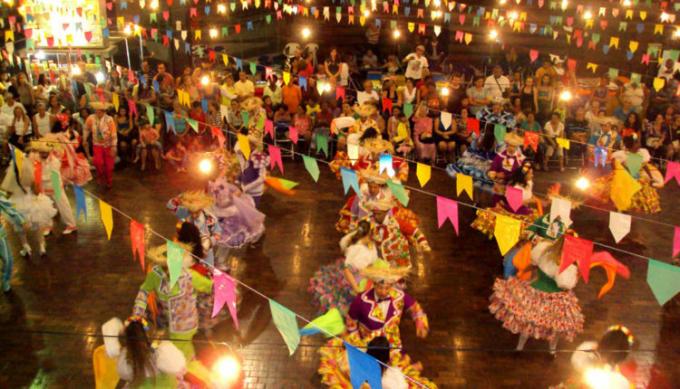A June celebration is the second largest popular party traditional that takes place in Brazil. Just behind the Carnival, it began in the country in the 17th century, after the arrival of the Portuguese.
It is a celebration that has a direct relationship with the popular catholicism by celebrating the existence of three Catholic saints: Saint Anthony, Saint John and Saint Peter.
see more
Youth and Adult Education (EJA) is once again a federal priority
Violence is responsible for the interruption of classes in 669 schools…
Its origin dates back to antiquity, when Europeans celebrated the solstice summer and winter and saluted the gods of nature and fertility. Thus, it emerged as a pagan festival.
From the consolidation of Catholic church at the European continent, the religious institution is unable to end the popularity of the pagan celebration that aimed to ward off pests and evil spirits that could damage the crops.
Thus, the Church adheres to the festival in order to attribute a religious character, aiming to convert pagan peoples. In Brazil, the June festivities introduced characteristics of cultures
African It is indigenous, which is why it has different traits in each region of the country.The biggest São João festival in the world takes place in Brazil, in the city of Campina Grande, Paraíba.
Check out the following lesson plan about Festa Junina that the Escola Educação team prepared for you to develop in your class. It is directed to child education and 1st year.
Festa Junina Lesson Plan
THEME: June celebration
YEAR: Child education
DURATION: 3 lessons of 50 minutes each
GOALS:
- Promote creativity;
- Show the importance of traditional popular festivals;
- develop attention
- Raise children's interest in country culture;
- Develop motor coordination;
- Stimulate memory.
DIDACTIC RESOURCES:
- school board
- Chalk or chalkboard brush
- Video
- white sheet
- Colored pencils
- To reproduce the images: computer, TV, video projector or printed photos
DEVELOPMENT
Class 1
For the first class, select images that portray June festivities, such as the ones below:



Ask the children the following questions:
- Have you ever attended parties like these?
- Have you ever seen people dressed like that?
- Have you dressed like these people?
Listen carefully to each answer and encourage them to dialogue. Thus, you will be able to identify children who do not have good diction, in addition to encouraging them to express themselves.
After the dialogue, put the first image on the screen again and ask what colors they see in the photo. As they speak, ask them to look for the color among their colored pencils and hold them up. This moment is important to exercise the child's memory.
If a child does not have the indicated colored pencil, ask him to go to the nearest child who does.
For each color spoken, write the name in large letters (block letters) on the board. Before writing, ask the children which letter you should use.
Example: suppose they say the color YELLOW. Pronounce the letter "A" calmly and ask the children what would be the first letter you should put on the board.
Then pronounce the next syllable, “MA”, then do the same movement, ask the children to say what the next letters would be and so on.
After writing the whole word on the board, go letter by letter and go over the name of each one with the children. Select at least five colors for you to write on the board.
Once this is done, ask the children who said they had already attended this type of party what typical food that they ate that pleased them the most.
Then, show an image with some June feast foods:

Ask the rest of the class to name these foods and which they have eaten and liked best. It should be noted that even children who have never attended a June festival have already eaten the foods sold there.
Once this is done, ask the children to draw a picture in which the setting is a June festival. Ask for the drawing to contain typical foods and clothing.
Class 2
The first moment of the second class will consist of the transmission of the animation The Feast of Saint John – Sitio do Picapau Amarelo – Episode 47, available on YouTube.
Ask what they thought of the drawing and if Uncle Barnabas and Aunt Anastácia's action was correct. Emphasize that cooperation is necessary in all situations. Say we should help each other instead of competing.
After the dialogue in which you disapprove of the two characters' action and praise the moment when everyone helps with the decoration, fix the video at the moment when the party is ready.
Ask the children what they see in the decor. Ask them to draw flags, typical foods, bonfires, tents. Delegate what each one will do.
When all the drawings are ready, decorate the classroom with them.
Class 3
The last class will consist of video transmission: square dancing, also available on YouTube.
Ask the children what they thought of the dancing and music and what was the best moment. Invite them to reproduce the quadrille in the classroom. Have fun!
Learn more at:
- Decoration Festa Junina For Birthday
- Lesson Plan Festa Junina and Brazilian Culture
- 16 Festa Junina sweets; Brazilian typical sweets
- Festa Junina for Coloring; 15 Drawings for children
- 11 June Party Souvenirs
